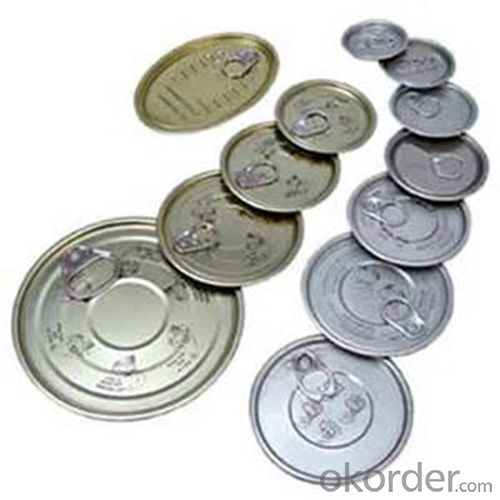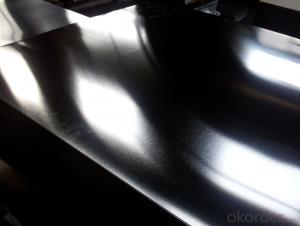Prime Quality Tinplate and Tin Free Steel
- Loading Port:
- Shanghai
- Payment Terms:
- TT OR LC
- Min Order Qty:
- 25 m.t.
- Supply Capability:
- 25000 m.t./month
OKorder Service Pledge
OKorder Financial Service
You Might Also Like
Item specifice
1.Structure of Prime Quality Tinplate and Tin Free Steel Description
Tin Free Steel (TFS) is thin black plate with two coats; one of metal chrome film and the other of chromium oxide. TFS is ideal for the manufacturing of crowns, container ends & shallow drawn cans etc. TFS is also known as Chromium coated steel.
2.Main Features of the Prime Quality Tinplate and Tin Free Steel
Chromium coated
Corrosion Resistant
Easier to recycle.
Sulphur Blackening Resistance: TFS has sulphur resistance properties, which can be used for canning protein- rich food such as fish.
Filiform Rust Resistance: Filiform is superficial corrosion of the base metal. TFS has a superior base metal which makes it corrosion resistance.
TFS should be Lacquered / Coated to prevent rust in humid condition.
Internal Coating / Lacquering can be avoided in the case of TFS used to store motor oil or cooking oil.
3.Prime Quality Tinplate and Tin Free Steel Images


4.Prime Quality Tinplate and Tin Free Steel Specification
Standard: ISO 11949 -1995, GB/T2520-2000,JIS G3303,ASTM A623, BS EN 10202
Material: MR,SPCC
Thickness:0.15mm - 0.50mm
Width: 600mm -1150mm
Temper: T1-T5
Annealing: BA & CA
Coil Inner Diameter: 508mm
Weight: 6-10 tons/coil 1~1.7 tons/sheets bundle
Passivation:311
Oil: DOS
Surface: Finish,bright,stone,matte,silver
5.FAQ of Prime Quality Tinplate and Tin Free Steel
-What is MOQ?
Our MOQ would be 25 tons.
- Do you only have prime quality?
We can supply both prime and second quality.
- Q:What are the different closure options for tinplate packaging?
- The different closure options for tinplate packaging include twist-off lids, crown caps, pry-off tops, friction-fit closures, and lever lids.
- Q:The composition of tinplate?
- Tinplate is a tin covered with tin, it is not easy to rust, also known as tin iron. This kind of galvanized steel in a long time Chinese called "tin", some people think that the tin plate cans was made from the Guangdong province of Macao (English Macao for tinplate imports, readable) so called "tin".
- Q:What are the advantages of using tinplate for electrical enclosures?
- There are several advantages of using tinplate for electrical enclosures. Firstly, tinplate offers excellent corrosion resistance, ensuring the durability and longevity of the enclosure even in harsh environments. Secondly, tinplate has high strength and rigidity, providing robust protection for the electrical components inside. Additionally, tinplate is a cost-effective option compared to other materials, making it a popular choice for mass production. Lastly, its malleability allows for complex shapes and designs, providing flexibility in enclosure manufacturing.
- Q:Does tinplate require any specific handling or storage conditions?
- Yes, tinplate requires specific handling and storage conditions. It should be stored in dry and well-ventilated areas to prevent corrosion. It is also important to avoid direct exposure to sunlight and extreme temperatures. Additionally, tinplate should be handled with care to prevent any damage or deformation.
- Q:How does tinplate contribute to the preservation of paint products?
- Tinplate contributes to the preservation of paint products by providing a durable and protective packaging solution. It is a corrosion-resistant material that prevents the paint from coming into contact with oxygen, moisture, and other external factors that can lead to degradation or spoilage. Additionally, tinplate cans are known for their tight seals, preventing any leakage or contamination that could compromise the quality and longevity of the paint inside.
- Q:How does tinplate packaging contribute to product protection against moisture?
- Tinplate packaging acts as a barrier against moisture due to its inherent properties. The tin coating on the steel substrate provides excellent resistance to corrosion, preventing moisture from reaching the product inside. This protective layer ensures that the packaging remains intact, maintaining the product's quality and preventing any damage caused by moisture.
- Q:How long does tinplate take to corrode?
- The rate at which tinplate corrodes depends on various factors such as environmental conditions, exposure to moisture, and the presence of corrosive agents. Generally, tinplate is known for its excellent resistance to corrosion, and it can take several years or even decades before any significant corrosion occurs. However, it is important to note that the protective tin coating can wear off over time, making the underlying steel susceptible to corrosion. Regular maintenance and proper storage can help prolong the lifespan of tinplate and prevent corrosion.
- Q:How does tinplate contribute to the overall versatility of packaging?
- Tinplate contributes to the overall versatility of packaging by offering a wide range of benefits. Its durability, corrosion resistance, and ability to withstand high temperatures make it ideal for preserving and protecting various products. Tinplate can be easily molded into different shapes and sizes, making it suitable for diverse packaging requirements. Additionally, its metallic appearance provides an attractive and premium look to the packaging, enhancing the brand image. Overall, tinplate's versatility makes it a popular choice for a wide range of products, from food and beverages to cosmetics and electronics.
- Q:How does tinplate packaging contribute to food safety?
- Tinplate packaging contributes to food safety by providing a protective barrier against external factors that can contaminate or spoil the food. The tin coating acts as a barrier, preventing oxygen, moisture, light, and other contaminants from entering the package, ensuring the food inside remains fresh and safe for consumption. Additionally, tinplate packaging is durable and resistant to damage, reducing the risk of physical contamination. Its ability to maintain the integrity and quality of the food over extended periods further enhances food safety.
- Q:What are the main countries producing tinplate?
- The main countries producing tinplate are China, Japan, South Korea, and the United States.
1. Manufacturer Overview |
|
|---|---|
| Location | |
| Year Established | |
| Annual Output Value | |
| Main Markets | |
| Company Certifications | |
2. Manufacturer Certificates |
|
|---|---|
| a) Certification Name | |
| Range | |
| Reference | |
| Validity Period | |
3. Manufacturer Capability |
|
|---|---|
| a)Trade Capacity | |
| Nearest Port | |
| Export Percentage | |
| No.of Employees in Trade Department | |
| Language Spoken: | |
| b)Factory Information | |
| Factory Size: | |
| No. of Production Lines | |
| Contract Manufacturing | |
| Product Price Range | |
Send your message to us
Prime Quality Tinplate and Tin Free Steel
- Loading Port:
- Shanghai
- Payment Terms:
- TT OR LC
- Min Order Qty:
- 25 m.t.
- Supply Capability:
- 25000 m.t./month
OKorder Service Pledge
OKorder Financial Service
Similar products
New products
Hot products
Related keywords



























